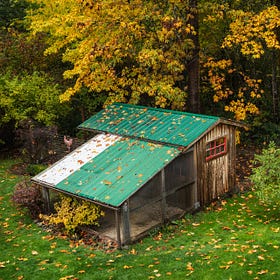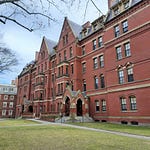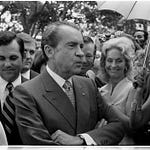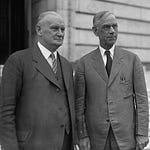
Last week, we introduced Project 2025's first stated goal: "Restore the family as the centerpiece of American life and protect our children." This week, we'll expand on that thought.
How could we improve the well-being of the American family while promoting interwoven, overlapping communities?
Presidential Perspectives on Homeownership: A Pillar of American Values
The conservative fourth President of the United States, and the primary author of the US Constitution, President James Madison: The Freeholders of the country would be the safest depositories of Republican liberty. In modern verbiage, we might paraphrase this by saying, ‘The property owners of the country would be the best protectors of Republican liberty.’
The liberal transformative thirty-second President of the United States, and a central figure in guiding the nation through the Great Depression and World War II, President Franklin D. Roosevelt: A nation of homeowners, of people who own a real share in their land, is unconquerable.
The GI Bill
On June 22, 1944, President Franklin D. Roosevelt signed the Servicemen's Readjustment Act of 1944 into law. The bill passed both the House and Senate unanimously and became commonly known as the GI Bill.
The GI Bill enabled veterans returning home from World War II to access higher education, job training, and home ownership. By 1951, eight million veterans used the benefit to advance their education, and another two and a half million used it to buy a home, farm, or business.
The bill reshaped social, economic, and educational landscapes in post-WWII America. It led to unprecedented levels of college attendance and homeownership among veterans of working-class backgrounds. The surge in educated and financially stable individuals contributed significantly to the growth of the middle class and the expansion of the US economy in the decades following the war.
The GI Bill demonstrated that the government could successfully act through the capitalist housing market to set conditions that would prompt housing market growth.
Owning a home became synonymous with the American Dream. It symbolized stability and a better future. The increase in homeownership shaped the cultural landscape of America, promoting values centered around family, home, and community.
***Note*** The 1950s was a time of extreme racism and unequal treatment of Americans. We should not return to the American culture of the 1950s.
In sum, with the GI Bill, government leaders acted through the capitalist housing market to set conditions to spur housing market growth. How did the capitalist housing market respond?
The Capitalist Housing Market Responds
The capitalist housing market responded by building homes for first-time homebuyers. Let’s look at an example.
Following World War II, America faced a severe housing shortage. Millions of veterans came home needing housing, adding sudden and intense demand to the housing market. During the war, construction materials and labor were redirected toward the war effort, significantly reducing residential construction. Young Americans were having babies at a high rate, birthing a generation we call the Baby Boomers.
Through this storm, families struggled to find suitable shelter. Some lived in boxcars, chicken coops, and large iceboxes.
Small, Affordable Homes
My grandfather and great-grandfather built my grandparents’ first house. It was a short distance down the lane from the ranch house. My grandparents were 18-year-old newlyweds; they would go on to be married until he passed away nearly 50 years later.
The house was two used chicken coops they pushed together. One chicken coop became a room for sleeping, the other for daily activities. It was cold in the winter and hot in the summer.
Enterprising business leaders recognized the potential for profits in the housing market and sprang into action.
On August 2, 1947, Levitt & Sons broke ground for Levittown, New York, the first of three Levittowns they developed. Levittown and similar projects gave rise to the American suburbs and promised homeownership for working-class Americans who could not have dreamed of homeownership before the war.
The influence of Levittown extended beyond veteran communities. Builders across the country adopted the Levittown model, improving housing availability and making homes more accessible and affordable. The construction boom created jobs that benefited communities nationwide, improving the standard of living for many Americans. The demand led to innovation in building technology and practices, reducing costs and increasing the speed of construction.
New housing rules gave Americans new economic benefits. Before the new Veterans Administration (VA) and Federal Housing Administration (FHA) initiatives, first-time homebuyers had to put down an average of 58% of a home's purchase price to secure a mortgage (source: Kenneth T. Jackson, Crabgrass Frontier: The Suburbanization of the United States (New York: Oxford University Press, 1987), 204 and 236.) With the new rules in place, Levitt & Sons could qualify veterans for mortgages with no money down.
Over time, the GI Bill, Levittown, and similar initiatives shaped the American landscape and made homeownership a central element of the American Dream. National leaders expanded housing availability through the GI Bill and other initiatives, causing homeownership rates to soar by 20% from 1940 to 1960. Homeownership brought stability to many Americans of that generation.
Could we apply the GI Bill model to improve the well-being of American families and promote interwoven, vibrant communities? How might we incentivize young generations to protect American liberty and contribute to their communities?
There’s another personal piece relevant for context here.
I once returned home from fighting in a combat zone. I rotated out of theater, flew back to Baltimore, stayed overnight, and had my first bourbon in months. The next day, I flew the rest of the way home. I came home to my wife and one-year-old, and to a house we had purchased with the assistance of a GI Bill loan. The GI Bill cemented our stability and community reintegration.
In the months I was gone, I had forgotten parts of American culture. Everything was shockingly different—the cars, music, beautiful farms and ranches, churches, and communities. It was good to be back in America.
It’s not just veterans who make America great. Americans make America great.
Veterans serve their country with distinction, and so do other Americans. They volunteer at arts and theater events, nonprofits, and churches. They help keep neighborhoods safe and respond to fires and crashes. They volunteer their time and talents to improve their communities. Just as the GI Bill provided veterans like me with crucial support, extending homeownership benefits to Americans who serve their communities could strengthen our national fabric.
Should we incentivize civilian service with housing benefits akin to the GI Bill for veterans to enhance the well-being of American families and build cohesive communities?
There would be many specifics to iron out. How many years of community service would qualify? How would we verify that individuals met their commitments? Would all nonprofits qualify?
I’m inclined to believe that the vast majority of people are good, and we need to extend benefits to first-time homebuyers simply because it’s the right thing to do for American families and, by extension, the country. Too many presidents from both parties across our history share the same opinion to believe in random chance.
However, part of the legislative process is communication and deliberation between parties. We should have frank discussions about how to strengthen American families while benefitting communities.
Let’s tie this all together.
Government leaders from both parties have demonstrated that we can act through the capitalist housing market to set conditions to spur housing market growth. The housing market has demonstrated that it responds to these initiatives.
Americans make America great, and many Americans serve their communities.
We can encourage Americans to serve their communities with homebuyer benefits to improve the well-being of American families and promote interwoven, vibrant communities.
May God bless the United States of America.
Postscript.
Some more Presidential Perspectives on Homeownership
President Thomas Jefferson: The small landholders are the most precious part of a state.
President James Madison: The Freeholders of the country would be the safest depositories of Republican liberty.
President Calvin Coolidge: No Greater contribution could be made to the stability of the Nation, and the advancement of its ideals, than to make it a Nation of homeowning families.
President Herbert Hoover: [Homeownership makes] a more wholesome, healthful and happy atmosphere in which to bring up children.
President Franklin D. Roosevelt: A nation of homeowners, of people who own a real share in their land, is unconquerable.
President George W. Bush: To give every American a stake in the promise and future of our country, we will…widen the ownership of homes and businesses…preparing our people for the challenges of life in a free society.
President Barack Obama: We’ll make owning a home a symbol of responsibility, not speculation — a source of security for generations to come, just like it was for my grandparents.















Share this post